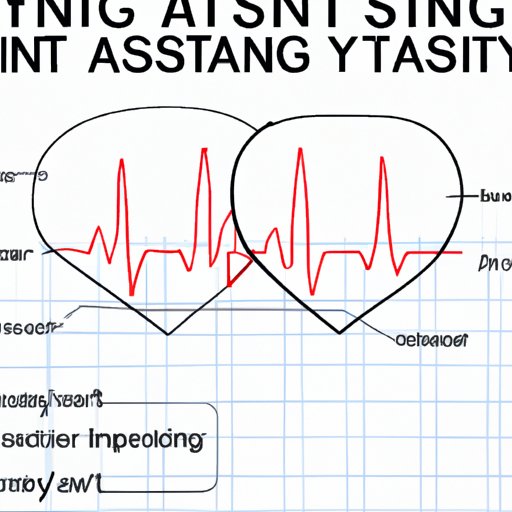Introduction
Inappropriate sinus tachycardia (IS Tachycardia) is a type of abnormal heart rhythm disorder. It occurs when the heart rate increases beyond the normal range without any physical exertion or external stimulus. IS Tachycardia can cause a variety of symptoms, including palpitations, chest pain, shortness of breath, dizziness, fatigue, and lightheadedness. If left untreated, it can lead to serious health complications such as heart failure, stroke, and even death.
For those living with IS Tachycardia, exercise can be a challenge due to the potential risk of exacerbating symptoms. However, regular exercise is important for maintaining overall health and wellbeing. The good news is that there are strategies that can help make exercising with IS Tachycardia safer and more manageable. In this article, we’ll explore how to identify the symptoms of IS Tachycardia, the benefits of low-impact cardio exercises and strength training exercises, and ways to create an action plan to address symptoms of IS Tachycardia during exercise.
Identifying the Symptoms of Inappropriate Sinus Tachycardia and How to Exercise Safely
The first step in exercising safely with IS Tachycardia is to recognize the symptoms of the condition. Common signs and symptoms include a rapid or irregular heartbeat, chest pain, shortness of breath, lightheadedness, and fatigue. These symptoms should not be ignored and should be addressed by consulting your doctor.
Once you’ve identified the symptoms of IS Tachycardia, it’s important to evaluate your heart rate during exercise. Your target heart rate should be based on your age and fitness level, but for people with IS Tachycardia it may be lower than the recommended range. Speak to your doctor about what your target heart rate should be and monitor your heart rate during exercise to ensure it stays within the safe range.
It’s also important to understand the limitations of exercise for people with IS Tachycardia. For example, high-intensity exercises that involve intense bursts of energy and speed may not be suitable for people with IS Tachycardia. Additionally, any activity that causes your heart rate to increase too quickly should be avoided. Pay attention to your body and stop immediately if you feel any symptoms of IS Tachycardia.
Understanding the Benefits of Low-Impact Cardio Exercises for People with Inappropriate Sinus Tachycardia
Low-impact cardio exercises can be beneficial for people with IS Tachycardia because they allow you to get your heart rate up without putting too much strain on your body. Some examples of low-impact cardio exercises include walking, swimming, and cycling. Walking is a great option as it’s easy to do and doesn’t require any special equipment. Swimming is also a good choice as it’s low impact and provides resistance. Cycling is another effective way to get your heart rate up without putting too much stress on your body.

Exploring Different Types of Strength Training Exercises that Can Be Modified for Inappropriate Sinus Tachycardia
Strength training is an important part of any exercise program, and there are several types of exercises that can be modified for people with IS Tachycardia. Bodyweight exercises such as squats, lunges, and push-ups are a great way to build strength without putting too much strain on your body. Resistance band exercises are also an effective way to build strength without using weights. Finally, weighted exercises can be done with lighter weights and higher repetitions to reduce the strain on your body.

Developing a Customized Exercise Program for Patients with Inappropriate Sinus Tachycardia
Once you’ve identified the types of exercises that are best for you, it’s time to create a customized exercise program. Start by consulting with your doctor to determine what type of exercise is best for you and what your target heart rate should be. Then, create a schedule that works for you and set realistic goals. Make sure to incorporate rest days into your routine to give your body time to recover.

Creating an Action Plan to Address Symptoms of Inappropriate Sinus Tachycardia During Exercise
In order to exercise safely with IS Tachycardia, it’s important to create an action plan to address any symptoms that may arise during exercise. First, prepare for exercise by getting enough sleep, eating a balanced diet, and drinking plenty of water. During exercise, monitor your heart rate and take breaks if needed. Also, be sure to take any medication as prescribed by your doctor.
Conclusion
Exercising with IS Tachycardia can be a challenge, but it’s possible to find ways to safely incorporate physical activity into your routine. Start by recognizing the symptoms of IS Tachycardia and evaluating your heart rate during exercise. Then, focus on low-impact cardio and strength training exercises and develop a customized exercise program. Finally, create an action plan to address any symptoms that may arise during exercise. With the right approach, you can stay active and maintain your health while living with IS Tachycardia.
(Note: Is this article not meeting your expectations? Do you have knowledge or insights to share? Unlock new opportunities and expand your reach by joining our authors team. Click Registration to join us and share your expertise with our readers.)
